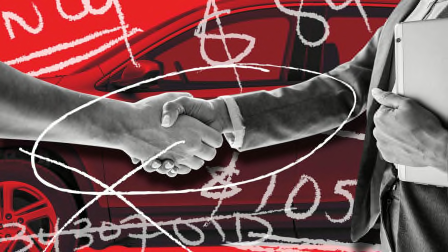How to Get the Best Car-Loan Rate Despite a Low Credit Score
The best rates go to those with good credit, but there are still ways to save money if your credit has room for improvement

If you’ve ever financed the purchase of anything—whether it was a car or a refrigerator—you know your credit score is key to getting a favorable interest rate. The best car deals are reserved for those with the best credit, but that doesn’t mean you have to accept the worst terms if your credit isn’t so good.
A good credit score usually means you can get a lower interest rate, while a poor credit score—or having no credit because you’ve never financed anything—can push you into the subprime category. To the lender, a low credit score means you’re a higher risk—or, according to their statistical calculations, less likely to pay back the loan. So you end up having to pay a higher interest rate, which adds significant finance costs on top of the purchase price of the car (or anything else) you’re buying.
Anywhere from a fifth to a quarter of all car loans fall in the subprime category, according to Eric Lyman, co-founder of ReMarkit Automotive, a firm that tracks auto sales trends. That’s more than 5 million car loans per year. And, he says, auto loan delinquencies, currently at nearly 2 percent overall—and more than 7 percent among subprime borrowers—are at their highest rate since 2006.
How to Save Money
In conversations with lending-industry experts, CR found that there are a number of ways to save money, even if you have a suboptimal credit score.
Know your credit score. Experian recommends checking your credit score at least once per year as a matter of course. That way, you’ll know where you stand so that you can manage expectations regarding loan eligibility, and be aware of what you have to do to bring up your score. You should also look for errors in your credit report, which can affect your score, Bell says.
“Luckily there is no shortage of sites you can visit online to get a free credit score," says Nana-Sinkam. In fact, credit bureaus Equifax, Experian, and TransUnion have announced permanent, free weekly access to credit reports via AnnualCreditReport.com.
If there’s time, improve your score. A credit score can be improved in a number of ways, mostly by paying bills on time. Always pay credit card and other bills when they’re due, even if it’s only the minimum payment. This is good advice for any loan—the more you pay up front, the less you’ll pay in the long run.
Bring a bigger down payment. "This strategy reduces the amount of interest you will pay, since the amount you finance will be smaller," says Nana-Sinkam. Keep in mind that a down payment can take the form of cash, a trade-in, or a combination of the two.
Get prequalified. Much like knowing your credit score, getting prequalified for a loan from your bank helps manage expectations about what’s possible. Talk to your financial institution and see what’s available.
Nana-Sinkam says that before you get prequalified, it’s a good idea to review your credit report to see whether there are any disputable items. Every little bit helps, and just a few corrections can get you a better rate. Getting approved for a loan before you go to buy a car gives you yet another bargaining chip.
"When you get prequalified, you have a solid starting point for financing negotiations," says Bell. "Maybe the dealer can get you a better interest rate, and maybe they can’t, but at least you’ll know where you stand."
See what the dealer or manufacturer is offering. If you’re in the market for a new vehicle, the dealer or the manufacturer may have loan programs for subprime borrowers that are unavailable elsewhere. You have to dig around on their websites to see what’s out there, and keep in mind that this type of deal is typically going to be found on less-expensive entry-level models.
Consider buying a used vehicle. Although prices have been higher over the last couple of years, used cars generally cost less money to buy than new ones, and particularly among older models. Also, the value of a used car is more likely to stay stable for longer than a new car, which will depreciate rapidly. That means used-car transactions may pose less risk for the lender, meaning there is a higher likelihood that a subprime borrower will be approved for a loan.
If you go this route, Bell advises keeping an eye on the overall price of the car you intend to buy. Loan interest rates tend to be higher for used cars, and can eat into potential savings if you’re not careful.
Report suspected discrimination. Racial discrimination in auto lending is nothing new. Ally Financial, which services loans for several automakers, settled a discrimination lawsuit for $80 million only a few years ago.
An academic report published in December 2019 found that Black and Hispanic borrowers were 1.5 percent less likely to be approved for a loan and that they pay 0.7 percent higher interest rates, regardless of their credit. The study found that although bank loans—which are federally regulated—were much less likely to be discriminatory, more than 80,000 Black and Hispanic borrowers were denied loans they would have been approved for had they been white.
Loans offered by dealers are known as indirect loans, because the dealer arranges financing through a third-party company. But the dealer doesn’t have to share loan offers that come back from the lender with the borrower. This is how they mark up loans for profit, and as outlined in last year’s study, how dealers were able to charge minority borrowers more. A federal rule enacted in 2013 placed auto lending under the guidance of the Consumer Financial Protection Bureau (CFPB), and reduced discriminatory auto lending by 60 percent. But the rule was overturned by Congress several months before the 2018 midterm election.
“Unlike mortgage lenders, who report each application through the Home Mortgage Disclosure Act, auto lenders do not systematically report application or loan-level data, making it difficult for regulators to monitor lenders for discriminatory practices,” says Erik Mayer, one of the authors of the study. “We find the strongest evidence of discrimination in the Deep South, the Ohio River Valley, and parts of the Southwest. Our estimates of discrimination in auto lending correlate strongly with state-level measures of the prevalence of racial biases.”
If you suspect discriminatory lending, Mayer suggests filing a complaint with the CFPB or the Federal Trade Commission.




















